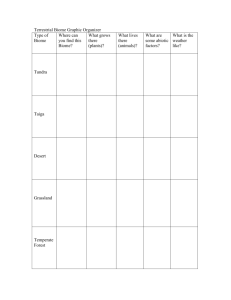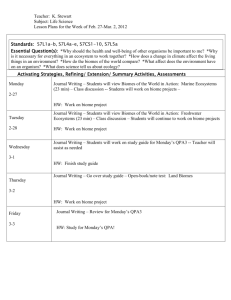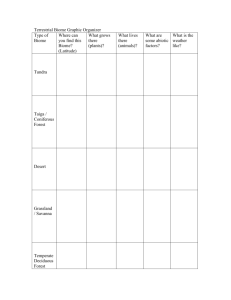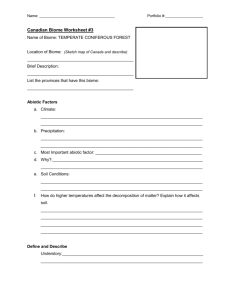Biome Study Guide - Atlanta Public Schools
advertisement
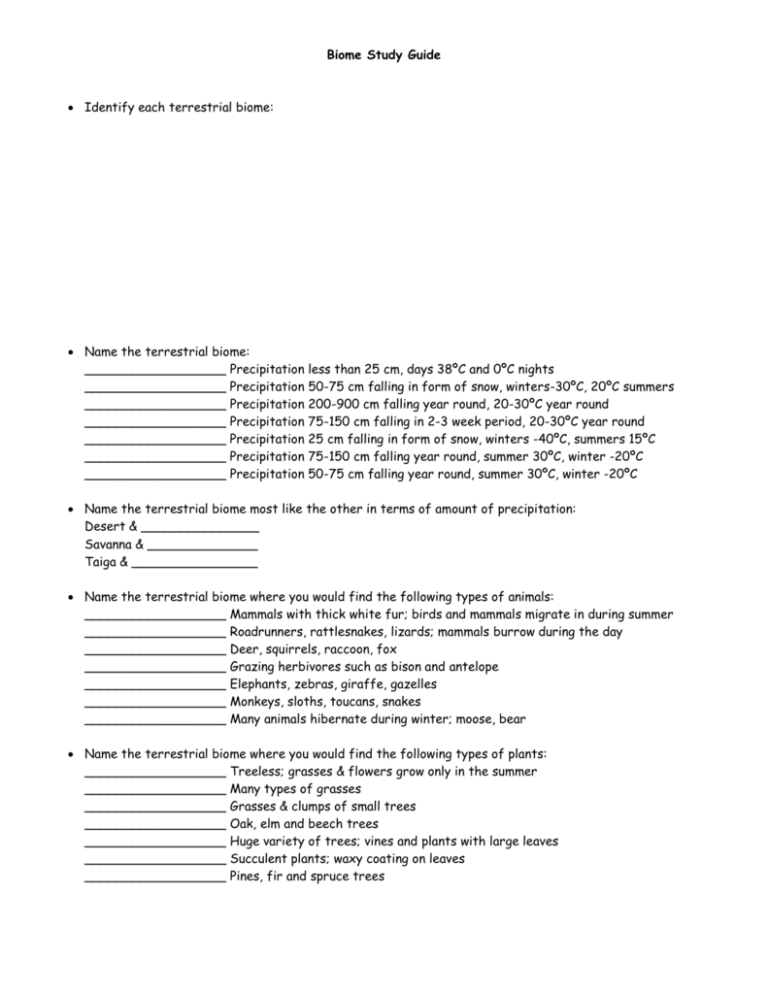
Biome Study Guide Identify each terrestrial biome: Name the terrestrial biome: __________________ Precipitation less than 25 cm, days 38ºC and 0ºC nights __________________ Precipitation 50-75 cm falling in form of snow, winters-30ºC, 20ºC summers __________________ Precipitation 200-900 cm falling year round, 20-30ºC year round __________________ Precipitation 75-150 cm falling in 2-3 week period, 20-30ºC year round __________________ Precipitation 25 cm falling in form of snow, winters -40ºC, summers 15ºC __________________ Precipitation 75-150 cm falling year round, summer 30ºC, winter -20ºC __________________ Precipitation 50-75 cm falling year round, summer 30ºC, winter -20ºC Name the terrestrial biome most like the other in terms of amount of precipitation: Desert & _______________ Savanna & ______________ Taiga & ________________ Name the terrestrial biome where you would find the following types of animals: __________________ Mammals with thick white fur; birds and mammals migrate in during summer __________________ Roadrunners, rattlesnakes, lizards; mammals burrow during the day __________________ Deer, squirrels, raccoon, fox __________________ Grazing herbivores such as bison and antelope __________________ Elephants, zebras, giraffe, gazelles __________________ Monkeys, sloths, toucans, snakes __________________ Many animals hibernate during winter; moose, bear Name the terrestrial biome where you would find the following types of plants: __________________ Treeless; grasses & flowers grow only in the summer __________________ Many types of grasses __________________ Grasses & clumps of small trees __________________ Oak, elm and beech trees __________________ Huge variety of trees; vines and plants with large leaves __________________ Succulent plants; waxy coating on leaves __________________ Pines, fir and spruce trees Name the terrestrial biome(s) described: __________________ Long dry and hot rainy season __________________ 4 seasons, many trees __________________ Poor soil due to the many plants quickly taking up the nutrients __________________ Rich soil due to the many decomposing leaves __________________ Soil is permafrost __________________ May be located anywhere; Always very dry; may be cold or hot __________________ Furthest north biome __________________ Greatest diversity of plants and animals on earth __________________ Largest land biome __________________ Located just below the tundra __________________ Name the biome in which Georgia is located __________________ & __________________ Two biomes closest to the equator __________________ & __________________ Two mid-latitude biomes (between equator and poles) Short Answer 1. Name and describe the three layers of the rainforest. 2. Why are most plants and animals found in the canopy of the rainforest? 3. Why do the plants in the under story of the rainforest have broad, flat leaves? 4. Name two reasons that the grassland biome does not have trees. 5. Name two reasons that the savanna does not have many trees. 6. What is the major factor used to classify biomes? Be able to read a Climatogram 1. Which seasons are the rainiest? Spring, Summer, Winter or Fall? 2. Which months are the warmest? 3. How many millimeters of rain are received in July? _______________ Convert this to centimeters? _____________ Be able to pick two terrestrial biomes and create a Venn diagram to compare and contrast the following: - Animals - Plants - Precipitation - Seasons - Soil - Location - Temperature Label each zone in the Pelagic biome: Answer questions about the Pelagic biome: __________________ main producer in the Neretic zone __________________ the zone where coral reefs are found __________________ main producer in the Oceanic zone __________________ the zone where vent communities are found __________________ animal-like plankton __________________ the zone that is above the continental shelf __________________ plants and animals in this zone are adapted to life in and out of the water __________________ the zone beyond the continental shelf; down 200 meters Name the Fresh Water biome described: __________________ this biome has constantly flowing water __________________ this biome has shallow, standing water __________________ this biome has still, calm water that is typically deeper __________________ this fresh water biome is a breeding ground for many plants and animals __________________ the lower layer of this biome is decaying, decomposing matter Short Answer 1. Explain why plants cling to rocks in a river or stream. 2. How do fish filter feed in a river or stream? 3. Why are most of the plants and animals found in the upper layer of a lake or pond? 4. Of all water on earth, ____% is freshwater and ____% is salt water. 5. Why is there so little life in the Benthic zone of the ocean? 6. Name the biome that is a mixture of salt and fresh water. What is the importance of this biome?



